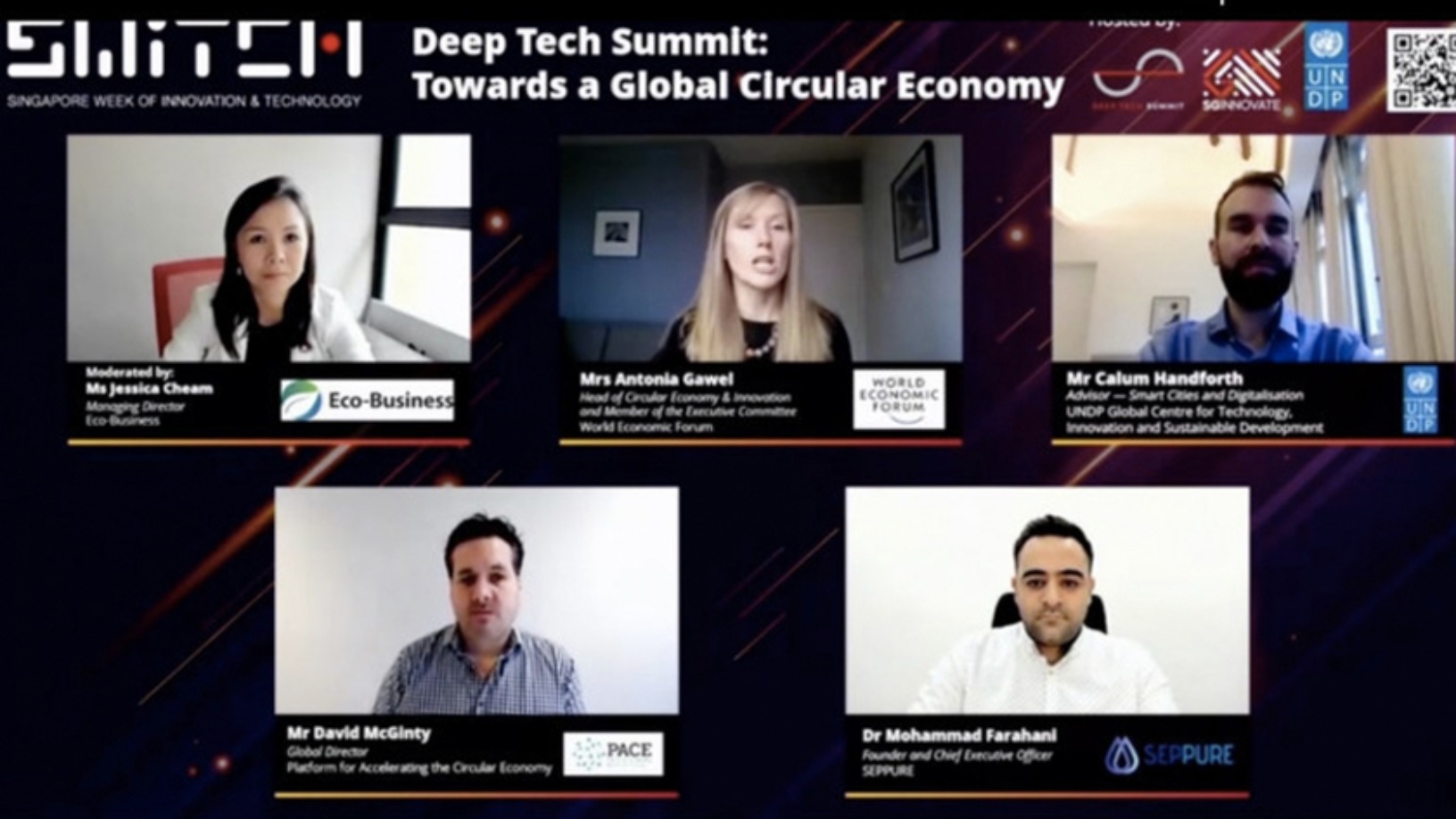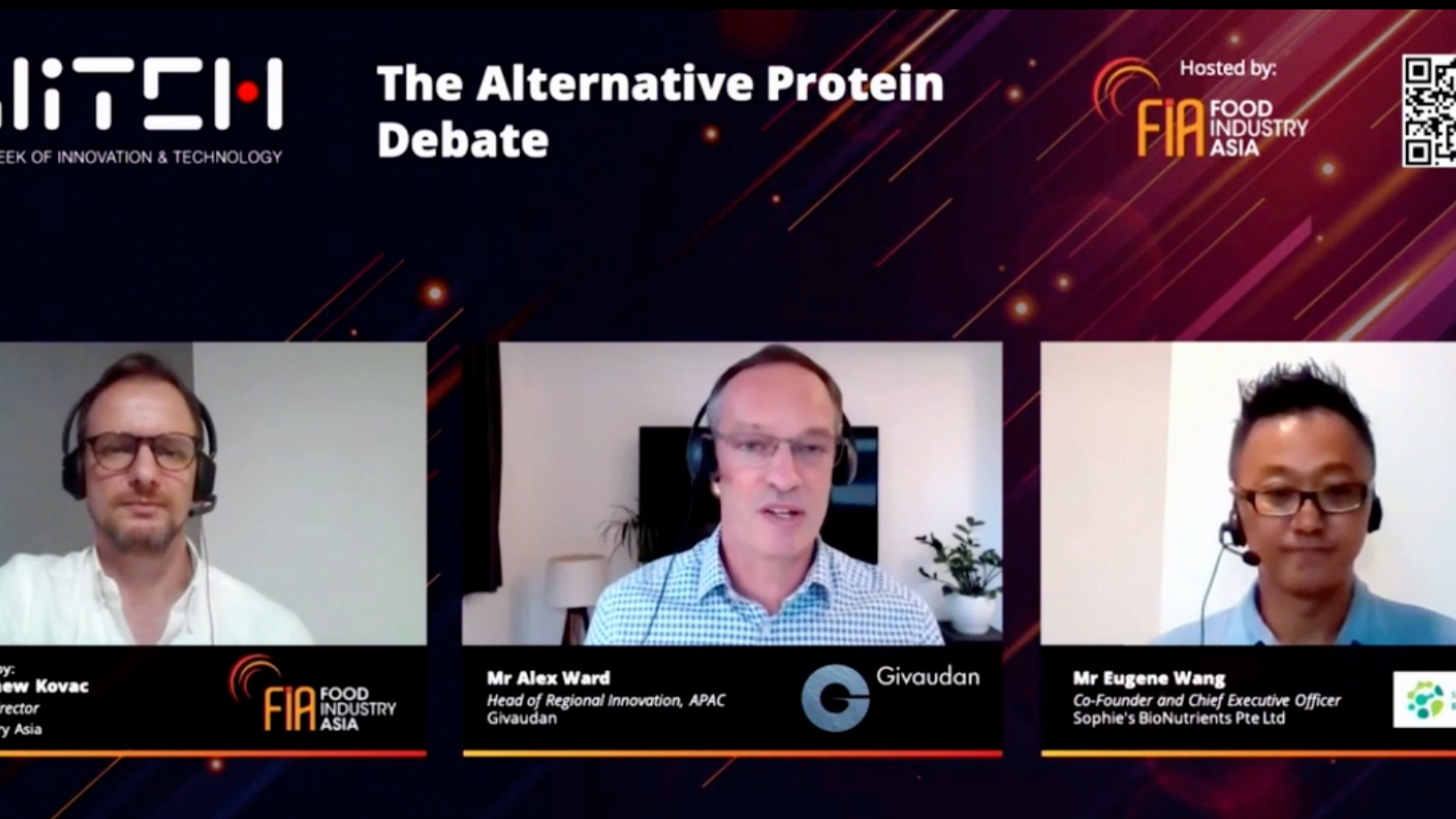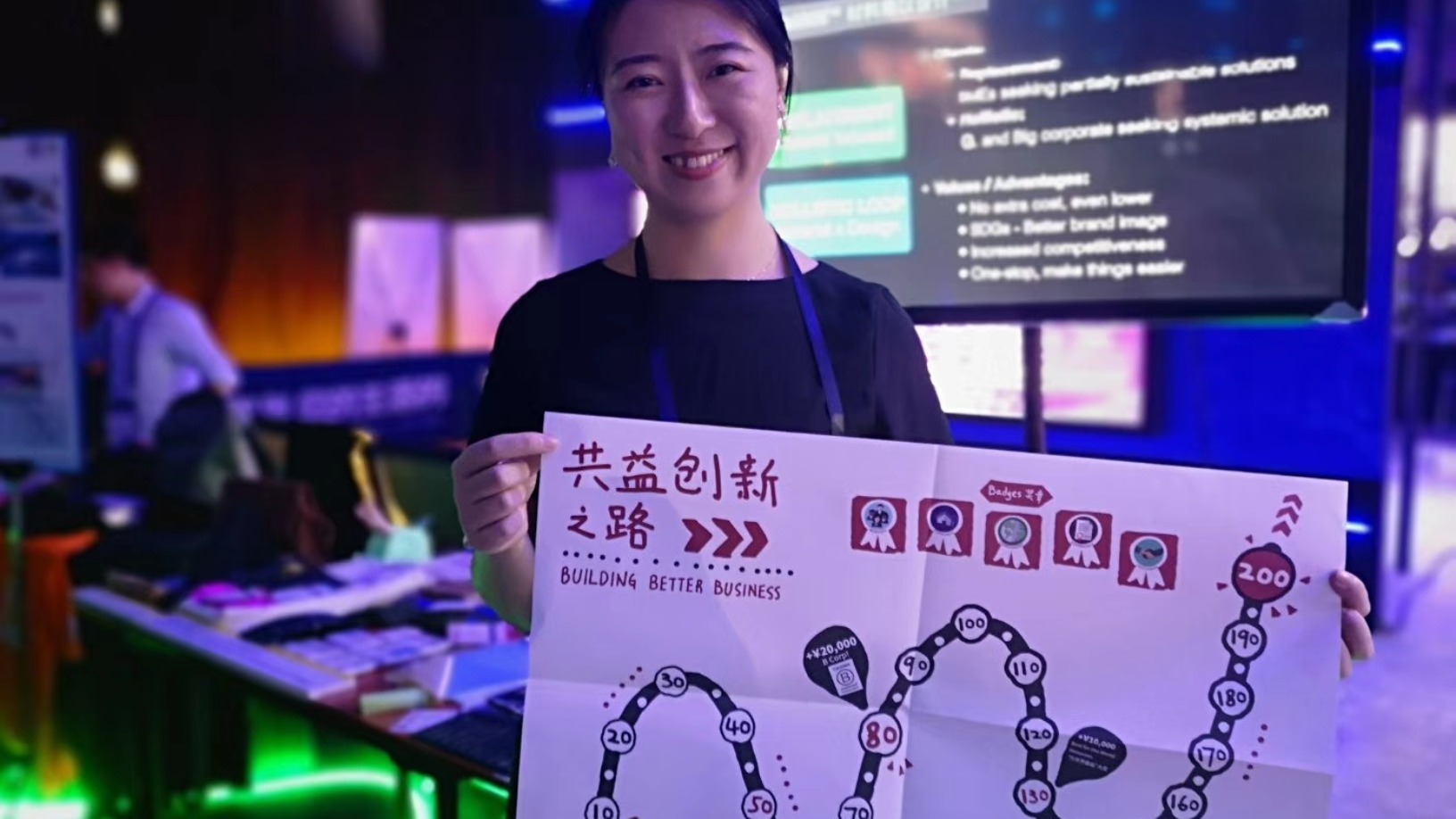Transitioning to a circular economy could help create $4.5tn worth of growth for the global economy over the next decade, according to the World Economic Forum (WEF). No surprise then that governments including China, the EU and Indonesia, as well as businesses, have been keen to tap that opportunity. Still, going circular remains a vast undertaking, and issues such as implementation, public education, regulation and standardization still abound.
A panel discussion during the Singapore Week of Innovation and TeCHnology (SWITCH) 2020 gathered key circular economy experts to shed light on these key issues, as well as on success cases. Sharing their insights and experiences were: Antonia Gawel, Deputy Head of PGPG and Head of Circular Economy and Innovation at the WEF; Calum Handforth, Advisor, Digitalisation and Smart Cities, of the United Nations Development Programme (UNDP); David McGinty, Global Director, Platform For Accelerating The Circular Economy (PACE) and Mohammad Farahani, CEO and founder of SEPPURE, a Singapore-based startup developing sustainable solutions for industrial chemical separation. Jessica Cheam, Managing Director of Eco-Business, moderated the panel.
Here are excerpts from the exchange. They have been edited for length and clarity.
Jessica Cheam: The World Economic Forum (WEF) issued a recent report, estimating that the circular economy can create $4.5tn in economic benefits by 2030 while helping the world achieve its climate targets. So, are you seeing businesses capitalizing on this opportunity?
Antonia Gawel: Yes, businesses are starting to capitalize on the opportunity, but not quite enough. At the WEF, we do see it as an incredible economic opportunity because there are so many wasted resources in our system right now.
For example, we now live in a world where the consumption of clothing has doubled, which, going forward, is expected to increase. We're dumping about one dump truck of plastics in the ocean every second. At the same time, the increased consumption has resulted in an incredible increase in extraction of natural resources. But the productivity of resources has decreased, so for every unit of resources that we're extracting, we're getting less value, less economic benefit into our system and our economies.
And that just doesn't make any sense. We have all these technologies, we're innovating, but we're becoming less efficient when it comes to using natural resources.
So, our mission is to help businesses and people understand that this system has gone too far in terms of mass consumption, to the detriment of both the environment and our economies. The impact that it's presenting on the environment is a risk. About half of the CO2 emissions result from such extraction, processing and use of natural resources.
Can you share some successful examples of public-private partnerships that are speeding up the transitioning to the circular economy that you've seen, and also perhaps some of the lessons that you've learned along the way?
Calum Handforth: What we're trying to do in the context of public private partnerships is two elements. The first is working upstream – working with policymakers and companies to understand how we design manufacturing processes well, how we design policy environments and regulatory environments in a sustainable and useful way.
The second element is working downstream – at the consumer level. We look at things like behavior change, and changing how people engage with the economy and how they engage with sustainability in their lives.
One of the challenges we’ve seen, in particular, is how the circular economy seems such a huge concept to many and finding the entry points can sometimes be quite tricky or daunting. What we’ve tried to do instead is to highlight the importance of experimentation, piloting and just taking tentative steps in terms of changing behavior, whether as a firm, a government or individual, and then building on those.
The struggles we’ve seen result from trying to adopt something wholesale, and then it fails because of the scale of change required. It does require significant change, but what we're finding is that for governments, companies and individuals, it's very much a journey toward a circular economy.
Gawel: Electronic waste, or e-waste, is the largest growing sector of waste globally, which is unsurprising as we're all probably sitting in front of about five or six electronic devices at the moment. The other side of that is there's about $63bn worth of leveraged value in electronic waste every year – and it's just sitting there.
The challenge here is that the costs and benefits of getting to those resources, extracting them and integrating them back into the system aren’t always necessarily aligned. However, there are companies that have recognized this and are starting to take action. We're working with companies like Dell, Philips, Apple and a number of others who have set very clear targets to be able to integrate materials back into their production system from used electronic devices, as well as rethink the way that they design those products to be able to do that effectively.
If the recovery of material isn’t thought of in the design, it is going to be a lot harder to later recapture that material back into your system. It is worth pointing out that there are challenges to doing this in practice. One is the economics – the distributed nature of a lot of these products makes it quite challenging to get them back, but it's not unsolvable.
The other thing is, to implement this requires policy to be aligned. In a number of countries, for good reasons, a lot of these materials and products are classified as hazardous waste, and so there are a lot of really careful regulations that have been put in place. But the flip side of that is it makes it very difficult to move these things back to production and manufacturing sites.
So that's where we need to rethink the system, which from a regulatory policy perspective has been designed for the management of dumping hazardous waste, to include the safe recovery of materials for reintegration into the systems.
Handforth: I think one potential leader in this area in this region is Indonesia. Our officers have been working with them to try and define a smart city, a circular economy policy and strategy for the entire economy there. This is very much about understanding how to get regulation to incentivize, work and support the companies.
Our engagement is very much partnering between governments and private sectors to provide more insights on both sides in terms of how regulation can incentivize and support Indonesia’s transition to a more sustainable way of working, eventually toward a circular economy.
Gawel: Indonesia, as Calum mentioned, is taking a leadership role in terms of the circular economy. They have set a target to reduce marine debris by 70% by 2025, which, by all measures is really difficult. And they themselves have said, look, we are not sure how to do this and how to achieve this target, and so they reached out to the international community.
We've been working with them for the past two years to construct a public-private partnership from the very top level of government to the companies – from the big international companies operating in Indonesia to the domestic producers. Over 150 leaders across different ministries and different businesses, civil society and waste picker associations are coming together to say, look, how can we help the government achieve this target? It is bold, it is ambitious.
That basically kick-started what is now a year and a half of process to design collectively a fact-based assessment and analysis of how that can actually be achieved, and then mapping out exactly the sort of investment requirements and policy measures needed. That works out quite differently across the different parts of the country. Indonesia is an incredibly complex archipelago, so it's difficult to get a lot of these things from one place to another.
Indonesia has, I think, demonstrated on a global scale what every single government should really be doing. And just being honest about the needs and involving partners can help achieve these objectives as well, because it’s not something that any one stakeholder can actually achieve on their own, either.
The impetus in Indonesia really came from observation – that there was a very observable problem that was accumulating. Indonesia has a huge tourism sector, which is impacted when you see piles and piles of waste in the river systems and on the beaches; it's not exactly the sight that tourists wish to see.
Also, the minister, Luhut Binsar Pandjaitan (Coordinating Minister for Maritime Affairs until October 2019), has played an incredible leadership role in this regard. He also recognized the links to human health, that the plastic that is being ingested, and at the end of the day, it is not something we’d want our people to suffer from.
So there was definitely leadership, individuals at senior levels within the government recognizing the issues, with an openness to collaboration, and a recognition that, again, this isn't something that any one individual or government alone can achieve, and therefore being open to bringing the pieces together
David, would you like to add your perspective on regulation?
David McGinty: With the European Green Deal – if you take that as a template – you can see there are some incentives and policies in place that are becoming consistently needed to enable the system's change.
One, is looking at subsidies for the reuse of materials as well as taxes on waste. We’ve got to have both of those working in conjunction to create the market incentives. The second is actually having recycling strategies reinforced with actual investments in the infrastructure. Now, we can get caught up in the innovation and the shininess of new business models, but you’d still need the fundamental infrastructure there to enable this flow, and that's missing, even in some of the wealthiest countries.
The other is looking at government procurement, and how you can take in account the total cost of ownership. So that means pricing in externalities into procurements to enable businesses to see the market signals and begin to invest in new products and services that are aligned to a circular economy. The other trend – and I'll say it quite bluntly – is looking to ban outright single-use plastics.
And the last I'd mention is something a little controversial – and there are a lot of details here and 20 plus years of experience – but if we look at those things I was talking about (subsidies for reuse of materials and taxing waste and looking at total cost of ownership) that means that carbon pricing becomes critical and we're really optimistic about some of the political environments possibly changing to open up the possibility for scaling these different alternatives for carbon pricing.
Farahani, in terms of innovation and the startup ecosystem that you're seeing right now, do you think the support is there for startups to consider circular economy principles and embedding them into the core of their business?
Mohammad Farahani: At the end of the day, it's going to be good for startups as it helps them reduce costs and be more efficient. As long as they can make their products recyclable, or if they reuse the raw materials that they already have, they are creating more value. It will also reduce the product cost and at the end of the day that’s good for customers, to pay less.
Governments might have engaged with big corporates, but when it comes to startups, there is no education for startups to know how they can move toward a circular economy, how they can recycle and reuse materials, how to apply circular economy principles.
Governments can also put in place incentives for big corporates to use new technologies coming from startups, which makes their processes or their industry more energy efficient and more sustainable. Corporates can source new technologies and try to do a quick pilot with startups. If it works, they can continue to inject money and resources to make that happen at industrial scale for themselves. So I think it's a matter of collaboration between government, startups and corporates.
Would we need some global standards on what count as “circular economy?" I’ve noticed, for instance, greenwashing in the market, where companies are claiming that they are circular, or that their products are greener, than they really are.
Handforth: Yes, we do see a real struggle there, and I think this is symptomatic of an issue that requires coordinated global and holistic actions. That is definitely where the UNDP can play a role, whether it's through showing best practices, bringing people to the table, or even working with governments to highlight the relevance of all these to their economies, societies, public health and other elements.
A bigger challenge is going to be maintaining this kind of global standard so you don't have, as you mentioned, greenwashing. You don't want a race to the bottom, but you also don't want a kind of regulatory shopping environment where companies are looking for countries with the lowest environmental standards to set up shop.
Those are very valid points. David, do you have anything to add on the global standards point of view?
McGinty: The International Organization for Standardization is working on standards right now around the circular economy, and there are also a lot of initiatives around different metrics and indicators for companies, for example, from the Ellen MacArthur Foundation. You see, governments too, for example, China, many European governments and Chile, are putting out global circular economy strategies with metrics aligned to them. So, there is a lot of move to standardize that, in that the data collection and metrics give you a way to standardize and focus your priorities.
What I’d say is we face a sort of a fundamental issue – whether we're looking at a global circular economy as the goal or we're looking at circular economy as a tool to achieve other goals. By “fundamental issue,” I mean, if you look at the UN's report on the 2030 Agenda for Sustainable Development, the circular economy most often gets placed under SDG 12, Sustainable Consumption and Production. Yet we don't have an understood definition of what sustainable consumption and production is.
We have a lot of ways to think about it. We have concepts like donut economics and planetary boundaries. They are quite abstract for translating into policy or into a business model. We have seen that because of that lack of definition and other reasons, there is underinvestment in sustainable consumption and production compared with other SDGs. Hence, it's important to show the transversal nature of a circular economy and how it is going to tangibly contribute to other impact areas.
If you're looking at embedding circular economy into your climate action plans, that's going to give you a certain set of priorities for a country to focus on and areas to stimulate for business. For example, if you have a lot of built environment or infrastructure, or you're a high-growth middle-income country, and you want to look at a lot more infrastructure investments, then you're going to want that circular principles embedded into those investments, and that's going to help you manage your emissions, both embedded and new emissions.
But if you're a high-growth emerging or developing country that might not have that same infrastructure investment, you're going to look at decent work as both a positive return for investment and also as a risk that you’d want to manage because you're going to have a transition impact on certain industries in the new markets that are being built.
So, I think we can get really specific about the metrics we want, at a national level and related to the real local environment. We were given a great example of Indonesia. It’s going to be a very different case if you go to Chile or Mexico, or if you come to Europe. So those countries will have their own metrics and then prioritize certain actions related to those impacts. That will then have that triggering effect to get greater investment and momentum in the circular economy.











